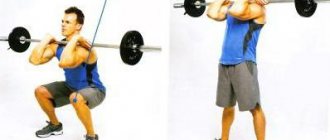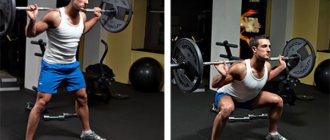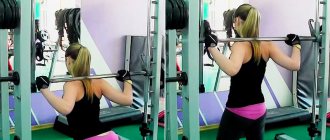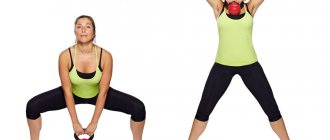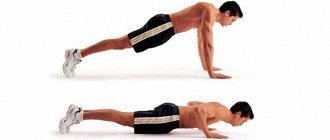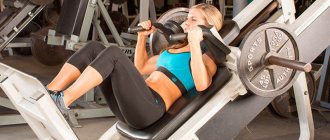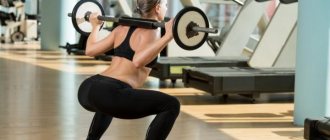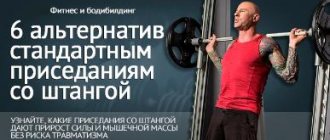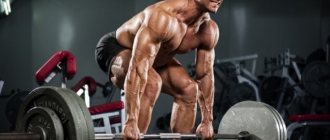Benefits and disadvantages
The exercise refers to narrowly focused techniques or variations of squats. The main purpose of performing a squat when the legs are narrow is to shift the load. In this case, the tension switches to the quadriceps (outer side). This makes this style of squats useful for creating the so-called “breeches,” which has long been an indicator of athletic fitness and physical development not only in men, but also in women. Also, such squats help improve the relief, and due to targeted pumping of the quadriceps (with a moderate diet), you can achieve pronounced separation in the hips.
The main advantages of the movement:
- Pumping the outer thighs (breeches).
- The best workout for the glutes.
- The ability to effectively work the quadriceps using lighter weights (for example, in case of problems with the spine, when excessive axial load is contraindicated).
- Improved balance and coordination.
- Development of flexibility.
- Improving the definition of the thighs.
The exercise has one drawback , and it prevents you from doing narrow squats with a barbell in a movement for constant progression (on a par with the classic squat).
We are talking about increased load on the knee joints, which almost eliminates working with heavy weights for a long time. Therefore, a squat with a narrow leg position is used for a short time, in certain microcycles and no more than 6-8 weeks.
Reverse hack squats
Hack squats are another good exercise that will help pump up a girl’s buttocks. It refers to the isolated. But in order to shift the load from the quadriceps to the buttocks, you need to do reverse hack squats, that is, squat facing the machine.
Hack machine squat technique:
Set the required weight on the machine; Stand facing the machine, squat slightly under it, place your shoulders under the special shoulder pads; Unlock the locking mechanism, place your feet shoulder-width apart closer to the top of the platform; As you inhale, slowly move your buttocks back as far as flexibility allows (no need to squat, knees only slightly bent); As you exhale, return to the starting position. Repeat the specified number of times.
What muscles work
Narrow leg stance uses the same muscles that work during classic squats, these are:
- Quadriceps.
- Gluteal.
- Biceps femoris.
- Adductor muscles of the thigh.
- Calf.
- Soleus muscle.
If your legs are narrow to each other, then the load will mainly go to the quadriceps, especially the lateral head. The gluteus medius and minimus are also better involved in the work, but only if the squat is performed until the thigh is parallel to the floor and below.
Barbell technique
Barbells and free weights are not the best choice for performing narrow-set squats. This is due to the fact that with this position of the legs it is much more difficult to maintain balance, especially if you want to sit quite low.
Technique:
- Remove the barbell from the supports, place the bar behind your back, on your rear delts, just below your neck.
- Place your feet at shoulder level (not close together), this is the starting position.
- Sit down with your back straight as low as possible.
- Without pausing, return to the starting position at a slightly faster pace.
It is important to ensure that the depth of the squat does not lead to rounding of the back. For a lower squat, it is recommended to additionally perform a complex of stretches, this will increase mobility and flexibility.
Squat technique
Without long introductions. Basic questions about squats:
— Positioning of the feet (wider, narrower, shoulder-width apart);
— Reversal of feet (has anyone even thought about this?);
— Emphasis on the heels/toes (which is correct?);
— Squat depth (the most controversial issue);
— Position of the knees (can the knees go beyond the toes?)
— Bend in the lower back (“butt wink” or when “the butt bites”);
- and a couple more nuances.)
- Positioning the legs.
The standard position of the legs when squatting is shoulder-width apart (1), or slightly wider (2). There is a dependence on height; as a rule, the taller the person, the wider the legs need to be placed in order to minimize the unwanted movement of the knees forward (beyond the toes) when squatting.
If we start from muscle work, then:
- with a wide stance: the back of the thigh, gluteal muscles, and inner thigh work more.
Separately about quadriceps. They also work with a wide stance, but the wider we place our legs and the more we turn our feet outward, the more the load shifts to the muscles of the inner thigh.
- with a narrow stance of the legs , the quadriceps is loaded more.
Bottom line: if you want to work the gluteal and inner thigh muscles, use a wide stance. If you want to work your quadriceps and outer thighs, use a narrow foot stance.
- Stop reversal.
Everything is simple here, the wider the position of the legs, the more you need to turn your feet outward. Why? When squats, the knees not be brought together with an X, otherwise this will lead to injury to the knee joint.
An example of an incorrect, “X-shaped” knee position when squatting/running:
- Emphasis on the heels.
One of the indicators that your technique and foot placement is correct is when the weight of the body/barbell presses on the heels and on the outer edge of the foot. If the weight presses on the toes, then a dangerous load is created on the knees. In this case, you need to adjust the weight of the barbell, the position of your legs, the tilt of your body, and perhaps change your shoes to more comfortable ones (flat-soled shoes are good for squats).
- Bend in the lower back.
When squatting, it is important to maintain a slight curve in the lumbar region. In this way, we transfer the load from the back to the gluteal muscles, forcing them to work as an extensor of the body.
Another point that is quite common during a “deep” squat is the tuck of the pelvis (“butt wink” or when the butt “pecks”).
Pelvic inversion may be associated with poor flexibility, tightness of the hip muscles, etc. This is a fairly common phenomenon, and in general it is not so terrible if the pelvis tucks in a little, but the back remains straight . But if the back is rounded, the load on the spine increases significantly, which can ultimately lead to injury.
Therefore, the main advice is not to lose the curve in the lower back when squatting. Sometimes it is better not to squat too deeply in order to maintain a natural curve, so as not to “drop your pelvis”.
- Squat depth.
This is the most controversial issue. And here I would recommend starting from your goals. If you are a professional athlete, then you probably have no choice, because... this moment is strictly regulated. But if you work out in the gym for yourself, then the depth of the squat should be determined by your technique . That is, if you can squat “deeply” and at the same time maintain the correct technique (head looks forward, straight back, pelvis does not peck, knees do not come together, emphasis on the heels), then great, a deep squat is completely suitable for you. But if your technique deteriorates with a deep squat, then it is better to abandon it.
What are the benefits of deep squats? Greater range of motion, more load on the muscles, and therefore better growth. But on the other hand, you can take more weight, reduce the range of motion (for example, squat until parallel to the floor) and still get the same load on the muscles. So, I repeat once again - the main thing is that the depth of the squat does not worsen your technique.
Perhaps the ideal option is a deep squat, with good technique (we sit down by moving the pelvis back, the torso is not tilted forward too much, we do not place the chest on the knees, the back is straight) and correctly selected weight (the maximum weight at which you still maintain the correct technique , and strain and stretch the gluteal muscles as much as possible). But this is ideal.)
An example of two correct variations of a deep squat:
- Knee position (can knees extend beyond toes?)
The general rule is “ when squats, your knees should not go beyond your toes .” If you are taller than average, you will need to place your feet a little wider to minimize unwanted knee padding/pushing forward (beyond your toes) when squatting.
The exception is deep squats (butt to heels). When doing a deep squat, your knees MUST extend beyond your toes, otherwise you'll end up arching your back, which is much more dangerous.
An example of when your knees MUST extend beyond your toes:
Once again I will return to the rule - “when squats, the knees should not go beyond the toes.” First of all, it is relevant for beginners, because... when we control our knees, the pelvis automatically moves back, the weight is transferred from the toe to the heel - this is exactly what is needed. Therefore, it is easier for a coach to say once, “watch your knees,” than to explain all the nuances (this is where the rule about knees came from; if you want, you can call it a myth). Remember that first of all you need to keep a straight back, your knees can go beyond your toes and in some cases must go out, otherwise you will not stand up with a straight back.
- Bringing your knees together when lifting.
A fairly common mistake in squats is bringing the knees together when lifting with an X. This can be due to incorrect positioning of the legs, if we do not point our toes out far enough, and it may also indicate insufficient development of the inner surface of the thigh. The wider the position of the legs, the greater the load on the inner thigh. If the muscles are weak, then the body transfers the load to the quadriceps, bringing the knees together with the X.
Once again I will return the picture with the “X-shaped” position of the knees when squatting/running:
The advice here is simple, experiment with positioning your legs, take lighter weights, develop your inner thighs (to help - squats with wide legs, side lunges).
- Smith machine and hack machine squats.
Very often, trainers in the gym put beginners to squat in a Smith or Hack machine. Firstly , it’s easier to install the equipment this way, and secondly, there ’s less need to explain.
But there are also negative aspects. Some call the Smith machine and the Hack machine a conveyor belt for “killing” the knees. When we squat in a hack machine (or in a Smith machine), the knees are pushed forward strongly, dropping below 90 degrees, the femur tends to move forward relative to the shin bones (and only the ligaments that prevent the femur from finally moving out of the joint). The second point is that when we squat in Smith and place our feet far forward from the bar, our back is in a very vulnerable position. Therefore, in general, general recommendations for these simulators are partial amplitude (in which even natural movement is close to a straight line), small weights and use the simulators at the beginning of the journey, or later for warming up.
If you are not a beginner, then I recommend moving away from squats in Smith:
Still, free weights are better, as they allow you to move along the path that is most natural for your body.
PS
And further…
— If you feel discomfort , especially pain (not muscle), then it’s better not to do it ;
— Squats also train the core muscles, and these include the abdominal muscles, so many people do not train the abs separately;
— When doing squats, intra-abdominal pressure increases (therefore, they are not recommended for pregnant women). If you cannot control your stomach when doing squats with heavy weights (your stomach should be pulled in), then wear a special belt;
— When squats, the bar should not lie on the neck , it should be lowered slightly to the shoulder blades.
— The most vulnerable position for the knees is a 90-degree angle at the knee joint. Squats to “parallel to the floor” are the most traumatic, since the entire load (stopping the weight, dead point) falls on a 90-degree angle in the knees (although many consider the most traumatic option to be a deep squat);
maximally load the gluteal muscles in squats, you need to make a more acute angle in the hip joint (see the picture below, the option on the left, by the way, pay attention to the correct position of the barbell on the back, and the position of the barbell relative to the feet);
— If the goal is to “round your butt,” then in addition to squats, there are a lot of effective exercises, which I examined in detail.
5 1 vote
Estimate
See also:
- Butt workout
- Where do the lost kilograms of fat disappear?
- How muscles work
Inventory options
Like regular squats, “narrow” squats can be done with any equipment and machines. The Smith machine is considered the most optimal. Fixing the barbell eliminates the main problem with free weights – the possibility of losing balance, which makes the exercise completely safe. Also, with this option, some stabilizing muscles are turned off. This is very useful when it comes to focused pumping of specific muscle areas.
The Smith technique is similar to the barbell version. Moreover, in Smith you can place your feet close together without the risk of falling backwards.
The option with dumbbells is not as convenient, but it is well suited for home conditions, where there are usually no other exercise machines or equipment. Dumbbells can be “thrown” onto your shoulders, which is more like a front squat. However, this technique will help you balance your weight better and reduce the risk of falling backwards. Also, the option with dumbbells allows you to perform perhaps the deepest squat, given the location of the weight.
Uneven-high squats[edit | edit code]
Uneven Squats
Execution[edit | edit code]
Stand straight with one foot on the floor and the other on a basketball. Feet should be shoulder-width apart or slightly wider. Keep your hands straight in front of you (Fig. 33). Lower yourself by bending your hips and knees until the thigh of your working leg touches your calf. You won't be able to go any lower, even though your foot on the ball isn't that tense. This is the final position (Fig. 34). Your body will likely swing backwards as you master the technique, so make sure you have somewhere to fall. In all deep squats there is a risk of falling backwards. Pause for a second before pushing your body up with both legs. Repeat. The golden rule of all squats: do not lift your heels off the floor, do not rise sharply, do not lean forward, no matter how difficult it is to perform the exercise. Use your power.
Cross-sectional exercise[edit | edit code]
Uneven-height squats are a major step up from single-leg squats. Until this stage, all exercises assumed a symmetrical load for uniform development of the legs. In this exercise, the foot on the ball does not receive the full volume of force load; it works more on maintaining balance while supporting the ball. Only the working leg receives the main load, lifting the body weight upward from the lowest point, which requires a lot of strength. This exercise helps improve balance and coordination.
Training norm[edit | edit code]
| First level | 1 set of 5 reps (both sides) |
| Average level | 2 sets of 10 reps (both sides) |
| Advanced level | 2 sets of 20 reps (both sides) |
Improving technology[edit | edit code]
More skill and strength are required than previous levels require. If you have trouble balancing the ball, use a more stable object, such as three bricks. If the problem persists, try reducing the height of the object - for example, take only one brick. Work until you can squat confidently in this position.
How to implement it into training
The narrow-foot squat is a highly specialized movement. It is not recommended to do it in the same workout as classic squats. The most convenient implementation methods are usually:
- Perform on an ongoing basis once every 2-3 weeks.
- Performing only “narrow” squats for 6-8 weeks or one training cycle.
- During a workout, it is enough to do 3-4 working approaches, especially if the last of them is failure or pre-failure.
- The repetition mode will depend on the goals and other conditions. But this type of squat works great both with a low number of repetitions (6-8) and in a high-repetition mode (12-20). Doing more than 20 repetitions is not recommended due to the stress on the knee joints.
And also read: How to do front squats with a barbell → Squats with dumbbells: technique and variations → Classic squats with a barbell →
Technique. From weightlifting to bodybuilding
The basics of exercise techniques where you need to pay particular attention to your back - deadlifts, squats - largely come from weightlifting. And in sports, technique is subordinated primarily to the main thing - effectiveness. And the strict requirement to keep the back rigid, maintaining lumbar lordosis, is due to the fact that this is the only way to ensure rigidity of the body and thereby give the barbell the necessary acceleration during the “undermining”. The acceleration should be such that the barbell is thrown up so that the athlete has time to perform the so-called. "slouched"
The forces from extension of the knee and hip joints should be immediately, completely, without shock absorption due to bending of the back, transferred to the barbell. Imagine that you need to sharply throw a weight hanging on the end of a rigid stick or flexible fishing rod. It is possible to do this only with a stick - the fishing rod, bending, absorbs shock. The stick is the spine, the rope is the arms, the weight is the barbell.
Another advantage of maintaining lumbar lordosis: the pelvis will not tilt backward and will provide a stable support for the contracting gluteal muscles.
Then squats and deadlifts migrated to bodybuilding, but recommendations on technique remained. It is no longer necessary to accelerate the barbell; you can lift it slowly, therefore, although in theory the need to keep a straight back was still declared, in practice they did not bother with this. Look at photos of legendary bodybuilders:
We tried, of course, to keep our back straight, but the main thing was the weight!
